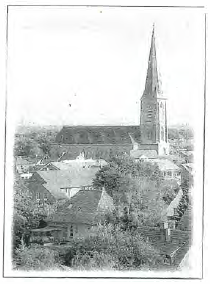The city of Dinklage has approximately 10,000 inhabitants and is located in Oldenburger Muensterland near the Dammer Mountains.
Sights of interest are the oldest water-castle in the whole area of Oldenburg, the Schweger windmill from the Netherlands, dated 1840 and Dinklage castle, which is surrounded by a large park, and hiking trails.
St. Catharina Catholic Church is in the center of town. Many of our ancestors belonged to this church. At this time there were a growing number of day laborers and tenants who lived in extreme poverty. There was also a decline in secondary occupations such as knitting and itinerant work in the Netherlands. A new life only seemed possible in America. Between 1840 and 1860 about 10,000 people left Oldenburg and immigrated to the United States. This was a considerable number compared to the 65,000 inhabitants at that time.
In 1781, the lieutenant Johann Hermann Anton Flensburg from Muenster mentioned the basic economical problem of the Oldenburg Muensterland: Due to the bad sandy soils there were no fruits without repeated, almost annual fertilization and the manure can not be obtained without livestock breeding, and livestock breeding is not possible without grassland and grassland is rare on the sand. This economic circulus vitiosus has been broken by drainage of bogs, the intensive livestock breeding and by industrialization.
 In 1871 the number of emigrations decreased and the number of inhabitants slowly started to increase. The tenants started earning extra money by hog feeding and calf fattening. Cigar factories followed and craftsmen establishments changed into manufacturers of agricultural machines.
In 1871 the number of emigrations decreased and the number of inhabitants slowly started to increase. The tenants started earning extra money by hog feeding and calf fattening. Cigar factories followed and craftsmen establishments changed into manufacturers of agricultural machines.
The mentality of the Muensterland people led to success. This has been described as “active Christianity, work, thriftiness, modesty, and a
special desire for property”.
Early emigrants to Ohio from this area wore the wooden shoes and had many customs from the areas near the Netherlands.

